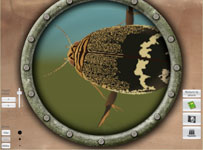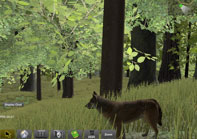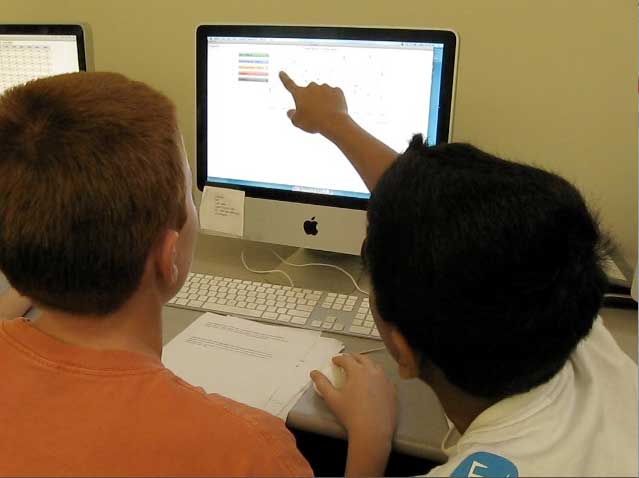

 The first MUVE represents a pond ecosystem, based on Black's Nook, a freshwater pond in Cambridge, MA.
Students explore the pond and the surrounding area, even walking under the water, and see different
organisms in their natural habitats. Students use a micro-submarine to zoom in and see the microscopic
organisms in the pond. They can learn about the organisms they find in a field guide and can construct
a food web. Students collect water measurements (e.g., temperature, dissolved oxygen, phosphates,
nitrates, pH, temperature), observe the weather, and make observations by exploring the terrain and
developments in the neighborhood of the pond.
The first MUVE represents a pond ecosystem, based on Black's Nook, a freshwater pond in Cambridge, MA.
Students explore the pond and the surrounding area, even walking under the water, and see different
organisms in their natural habitats. Students use a micro-submarine to zoom in and see the microscopic
organisms in the pond. They can learn about the organisms they find in a field guide and can construct
a food web. Students collect water measurements (e.g., temperature, dissolved oxygen, phosphates,
nitrates, pH, temperature), observe the weather, and make observations by exploring the terrain and
developments in the neighborhood of the pond.
 Students visit the pond over a number of virtual “days” – each day the pond and surrounding area look
different, people provide new information, and baseline data has altered. Students view the data over
time using tables and multi-dimensional graphs. Eventually, students make the surprising discovery that,
on a day in late summer, many fish in the pond have died. Students are challenged to figure out what
happened to the fish. They work in teams to collect and analyze data, gather information to solve the
mystery, and come to understand the complex causality of the pond ecosystem.
Students visit the pond over a number of virtual “days” – each day the pond and surrounding area look
different, people provide new information, and baseline data has altered. Students view the data over
time using tables and multi-dimensional graphs. Eventually, students make the surprising discovery that,
on a day in late summer, many fish in the pond have died. Students are challenged to figure out what
happened to the fish. They work in teams to collect and analyze data, gather information to solve the
mystery, and come to understand the complex causality of the pond ecosystem.
The EcoMUVE curriculum is based on national middle school science standards, on 21st century skills, and on the Understandings of Consequence Curriculum "Causal Patterns in Science" developed by Dr. Tina Grotzer at Harvard University.
The second MUVE is modeled on a hardwood forest ecosystem like those in the northern part of the United States. While exploring the plants and animals that live in the forest ecosystem, students learn about individual, population, and community levels in ecosystems. An interactive food web tool allows students to track the flow of energy through the populations in the ecosystem.
 Students work as teams to visit two forested islands over a span of fifty years to see how the
populations and forest structure change on each island over time. Both islands include populations of
deer; one also has a population of wolves, leading to very different effects. One island has a lot of
vegetation, is rich in insect diversity, and has many birds. The second island has little vegetation
and seems to lack many of the organisms that depend on the understory vegetation as habitat. By
monitoring changes over time, students learn that these two islands look so different due in large part
to the relationship between deer and their primary predator, the grey wolf.
Students work as teams to visit two forested islands over a span of fifty years to see how the
populations and forest structure change on each island over time. Both islands include populations of
deer; one also has a population of wolves, leading to very different effects. One island has a lot of
vegetation, is rich in insect diversity, and has many birds. The second island has little vegetation
and seems to lack many of the organisms that depend on the understory vegetation as habitat. By
monitoring changes over time, students learn that these two islands look so different due in large part
to the relationship between deer and their primary predator, the grey wolf.

Students work in teams to gather clues about the causal relationships in the Forest ecosystem by collecting population data, talking to people in the virtual world, collecting evidence from tree rings, building a food web, and exploring a decomposing tree stump.
Testing of EcoMUVE in the classroom has found that students made significant gains on pre-post content survey questions related to interactions between biotic and abiotic factors, the processes of photosynthesis and respiration, and the role of decomposition in gas exchange. Analysis of a causal understanding pre-post survey revealed significant increases in students’ understanding of the importance of effects over distance in analyzing ecosystem problems. On affective measures, students showed increased understanding of what scientists do in order to study ecosystems, and a greater self-efficacy for data analysis. A study comparing students who used EcoMUVE before or after a field trip to a local pond found that students who used EcoMUVE before visiting the pond made stronger scientific explanations of measurements they took at the pond.
I am most impressed that the unit made the kids THINK and draw conclusions, there was very little teaching and more facilitating. Students truly constructed and developed their own knowledge about ecosystems, the best way to teach science...constructivist approach, loved it!
